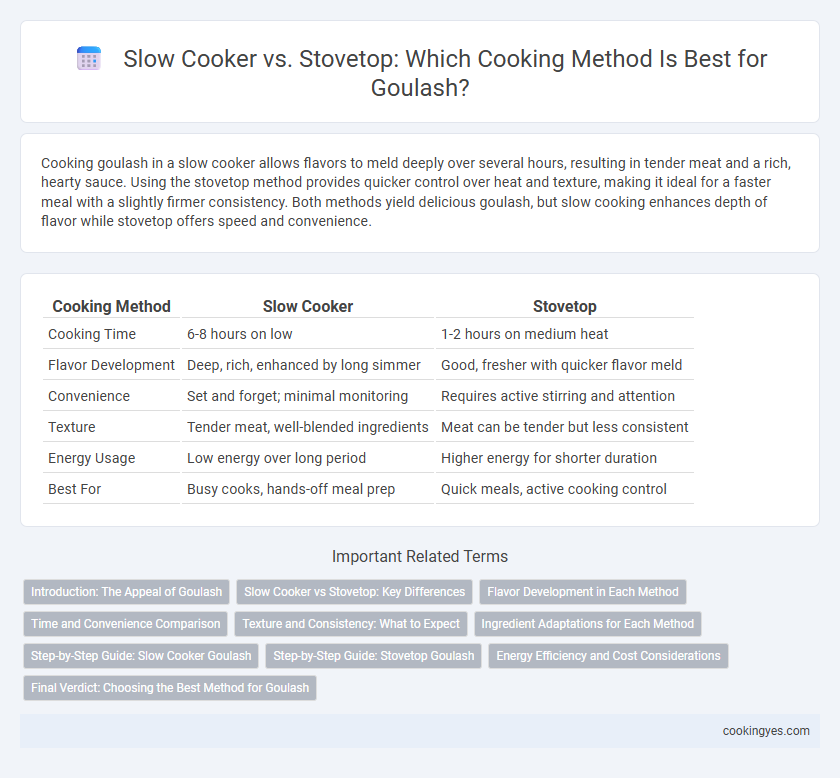Cooking goulash in a slow cooker allows flavors to meld deeply over several hours, resulting in tender meat and a rich, hearty sauce. Using the stovetop method provides quicker control over heat and texture, making it ideal for a faster meal with a slightly firmer consistency. Both methods yield delicious goulash, but slow cooking enhances depth of flavor while stovetop offers speed and convenience.
Table of Comparison
| Cooking Method | Slow Cooker | Stovetop |
|---|---|---|
| Cooking Time | 6-8 hours on low | 1-2 hours on medium heat |
| Flavor Development | Deep, rich, enhanced by long simmer | Good, fresher with quicker flavor meld |
| Convenience | Set and forget; minimal monitoring | Requires active stirring and attention |
| Texture | Tender meat, well-blended ingredients | Meat can be tender but less consistent |
| Energy Usage | Low energy over long period | Higher energy for shorter duration |
| Best For | Busy cooks, hands-off meal prep | Quick meals, active cooking control |
Introduction: The Appeal of Goulash
Goulash's rich flavors develop uniquely depending on the cooking method, with slow cookers offering consistent low heat that tenderizes meat and melds spices over time. Stovetop cooking allows precise temperature control and faster preparation, ideal for adjusting seasoning and texture in real-time. Choosing between slow cooker and stovetop impacts the depth of flavor and convenience, making it essential for achieving the authentic Hungarian stew experience.
Slow Cooker vs Stovetop: Key Differences
Slow cookers maintain a consistent low temperature for several hours, allowing goulash flavors to deepen and meats to become tender without constant monitoring. Stovetop cooking offers quicker preparation time and more direct heat control, ideal for those seeking a faster meal with adjustable texture. The slow cooker method requires less active effort, while stovetop cooking demands attention but provides greater flexibility in seasoning adjustments.
Flavor Development in Each Method
Slow cooker goulash enhances flavor development through prolonged, low-temperature cooking, allowing spices, meat, and vegetables to meld deeply and create a rich, tender dish. Stovetop cooking offers more immediate control over heat, promoting caramelization and Maillard reactions for a bolder, slightly charred flavor profile. Each method influences the texture and depth of taste, with slow cooking favoring softness and complexity, while stovetop yields a more robust, concentrated flavor.
Time and Convenience Comparison
Slow cookers offer a hands-off approach for goulash, requiring 6 to 8 hours on low heat, which enhances flavor development and tenderizes meat without constant monitoring. Stovetop cooking reduces preparation time to about 1.5 to 2 hours but demands regular stirring and attention to prevent burning or sticking. Choosing between slow cooker and stovetop methods depends on whether convenience and minimal supervision or quicker meal readiness is prioritized.
Texture and Consistency: What to Expect
Slow cooker goulash yields tender meat and a rich, well-blended sauce due to the prolonged, gentle heat allowing flavors to meld fully. Stovetop cooking offers more control over texture, enabling adjustments for a thicker sauce or firmer meat by altering cooking time and heat intensity. Expect slow cooker goulash to have a uniformly soft consistency, while stovetop goulash can vary from chunky to stew-like based on chef preferences.
Ingredient Adaptations for Each Method
Slow cooker goulash recipes often require diced vegetables and tougher cuts of beef to withstand long, low-heat cooking, allowing flavors to deepen and meat to tenderize without additional liquid adjustments. Stovetop methods favor quicker-cooking ingredients like ground beef and finely chopped onions, requiring more frequent stirring and closer heat monitoring to prevent burning or drying out. Adjustments in seasoning intensity and liquid volume vary between methods to balance flavor concentration and texture consistency.
Step-by-Step Guide: Slow Cooker Goulash
Slow cooker goulash begins by browning beef cubes to enhance flavor, followed by layering chopped onions, bell peppers, garlic, diced tomatoes, and paprika in the slow cooker. After adding beef broth and seasoning with salt and pepper, set the cooker on low for 6 to 8 hours or high for 3 to 4 hours until the meat is tender and flavors meld. This method offers hands-off cooking and consistent heat, making it ideal for developing deep, rich goulash flavors compared to the stovetop's quicker but more hands-on process.
Step-by-Step Guide: Stovetop Goulash
For stovetop goulash, begin by browning beef cubes in a heavy skillet over medium-high heat to develop rich flavor through caramelization. Add chopped onions, garlic, and paprika, then stir and saute until fragrant before deglazing the pan with beef broth to create a savory base. Simmer the mixture gently for 1.5 to 2 hours, stirring occasionally, until the meat is tender and the sauce thickens to a hearty consistency ideal for authentic Hungarian goulash.
Energy Efficiency and Cost Considerations
Using a slow cooker for goulash is more energy-efficient than a stovetop, as it maintains low, consistent heat over several hours, reducing overall electricity or gas consumption. Slow cookers typically consume between 75-150 watts, whereas stovetop burners can use up to 1,500 watts when on high heat, leading to higher energy bills. Cost-wise, slow cookers offer long-term savings by optimizing energy use, while stovetop cooking may incur greater fuel costs, especially during extended simmering periods.
Final Verdict: Choosing the Best Method for Goulash
Slow cookers enhance goulash by allowing flavors to meld deeply over several hours, resulting in tender meat and rich sauce. Stovetop cooking offers greater control over temperature and texture, ideal for quicker meals with slightly firmer ingredients. Selecting the best method depends on time availability and desired texture, with slow cookers favored for convenience and depth, while stovetop excels in speed and precision.
Slow cooker vs stovetop for goulash cooking method Infographic

 cookingyes.com
cookingyes.com